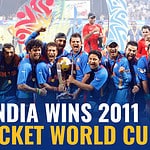After beating co-host Bangladesh by a whopping 87 runs, a very confident Team India came to play their 2nd match of the ICC Men’s World Cup on 27th February 2011 in the M. Chinnaswamy Stadium of Bengaluru, against the former Champion England, who also brought enough confidence from winning the previous match.
For such a high-stakes match, confidence is necessary, yes. And both the teams delivered on that, too. In fact, they delivered so much that the match itself resulted in an unprecedented tie! A total of 676 runs were scored in the match, and yet, it had no winner. The teams got a point each at the end of the match.
There was a gap of 1 ball in these two innings, though- India played 49.5 overs, losing all of their wickets to get the total of 338 runs, whereas England needed all 50 overs at the cost of 8 wickets to reach the same. Let’s dig in to unfold all the drama.
Sachin’s 120 Runs vs Bresnan’s 5 Wickets
Master Blaster Sachin Tendulkar is worthy of the tag with yet another century. He scored 120 runs from 115 balls and with ten 4s and five 6s! That was a show in & of itself for the supporters of both teams.
Yuvraj & Gmabhir Played Their Roles with Much Integrity
Sachin alone couldn’t have done it if he had not been supported by other batsmen in his squad, especially not after the considerably quick return of Virender Sehwag, making only 35 runs. Tim Bresnan made sure that the openers didn’t get to make a partnership by not only making a brilliant throw but also catching it himself. India’s total was just 46 runs at that moment.

But the English ballers could not really make much of that early wicket as Gautam Gambhir ensured a sustainable innings of 51 runs while supporting Sachin on the other end of the pitch. Both of them added more than 100 runs until Gambhir bade Adios right after his half-century.
The Indian squad was full of brilliant batsmen, and Yuvraj Singh came in to bat as evidence of that fact and beyond. His 58 runs came from 50 balls with 9 boundaries in it. After his dismissal, India lost wickets in regular intervals and a little fast too, with back-to-back 2 wickets after 305 runs and again after 327 runs of team total.
MS Dhoni’s Quick Innings, Virat Kohli’s Failure
In between these serial returns of batsmen, MS Dhoni didn’t forget to play his part as a captain. He added a very quick 31 runs from 25 balls with three 4s and one 6. But the previous match’s centurion, Virat Kohli, couldn’t shine at all in this match.
Tim Bresnan, on the other hand, kept on scalping wickets at all the crucial moments to make sure the target for his team to chase didn’t become too high. After taking out Sehwag’s wicket, he hunted down MS Dhoni, Yusuf Pathan, Virat Kohli, and Zaheer Khan (run out).
Strauss’s 158 Runs vs. the Indian Ballers
The batsmen of both squads played pretty much the same game, but the Indian ballers were a little more successful in terms of individual contribution than the English ones. While Zaheer Khan picked up 3 crucial wickets from Andrew Strauss, Ian Bell, and Paul Collingwood crumpling down the top-order as well as messing with the middle-order batting of the English Squad, his colleagues Munaf Patel and Piyush Chawla picked up 2 wickets each.

Before the Indian pacer packed him back to the pavilion, Andrew Strauss entertained the crowd with his thunderous innings of 158 runs from 145 balls with 19 boundaries- eighteen 4’s and one 6! He was aptly titled the ‘Player of the Match’. His innings seemed to do it for England, but except for Pietersen and Bell, none other of his colleagues made it that day against the Indian ballers.
Kevin Pietersen was not shining his brightest that day and added only 31 runs, while Ian Bell proved that Strauss was not alone in the fight, with 69 runs. But the Indian ballers kept on scalping down the English batting line-up till the total score reached 325 runs for 8 wickets after the 49th over.
Breath-Taking, Match-Deciding 50th Over
14 runs were required for England to win the match and only 6 balls to go. Munaf Patel came in to serve the final order with Graeme Swann and Ajmal Shahzad waiting with their bats on the pitch. Shahzad hit a huge six on the 3rd ball of that over and the batsmen managed only singles from the other 4 balls.
England needed just 2 runs from that last ball, but as Swann sent Patel’s last delivery to mid-off, he managed only a single to end the show, allowing oxygen back to every spectator’s lungs. Hence, a tie in a World Cup match!
Virat Kohli Batted in the Middle-Order?

Although the match was a tie, and India went on to win the championship in the end, one cannot help wondering why a specialist batsman like Virat Kohli was brought in to bat at no. 5? He proved himself enough in the very 1st match of his World Cup career with a century.
Did captain Dhoni think he was not ready to contribute to a match of such high stakes? Was coming to play at a lower position demotivated Kohli which hampered his performance that day? These questions may not matter anymore, but they could have if England had just one more ball or the last ball was wide or Swan did manage to take 2 runs off that last ball.
Nothing can please a cricket lover, especially at the stadium, than a match-deciding last over- except, of course, the victory of their supported team. M Chinnaswamy Stadium witnessed some of the happiest cricket lovers on that day of the ICC Men’s World Cup 2011, even though no team could call itself the winner. That day, cricket won!




